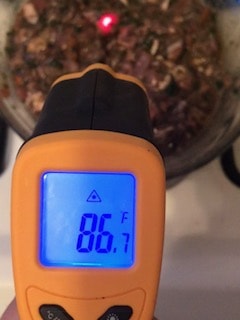Some content may contain affiliate links to products which means we could earn a fee on your purchase. Thank you for visiting
Dogs are like people in so many ways we really do think of them as our kids don’t we? It isn’t until we catch them “in the act” of doing something so unhuman; like eating gross things, or lifting their leg on our friend’s pant leg that we come face to face with that fact that they are (in fact) canines through and through. So it stands to reason that we wonder if things that bother us (like moving our bed around) would have the same effect on our dog. So let’s dive in:
Is it ok to move a dog’s bed around?
Yes! Not only is it okay to move a dog’s bed around, but the location of your dog’s bed should be routinely checked for these 3 sleep inhibitors:
- temperature
- drafts
- disturbing noises
These are the most popular reasons for moving a dog’s bed to different locations within the same room or even when moving a dog’s bed from room to room.
Now let’s learn how to check all 3.

How to Check Temperature of a Dog Bed Location
If you already own an infrared, laser thermometer then I don’t have to tell you about the countless uses of this amazing home gadget. It might actually be my favorite piece of equipment in the home. Sometimes you can get these handy tools for free along with many other dog supplies. You can read how to get free dog stuff here: link to our free dog stuff post.
Anyway, while there are about 100 reasons for owning one, the best reason for dog owners is because it can check the temperature of:
- blacktop driveways
- sidewalks
- car interiors
- doghouses
- porch and deck flooring
- and of course Your Dog’s Bed Location
Dog Bed Location Mistakes
Most dog owners, especially with large breeds, instinctively place their dog’s bed alongside a wall so that it is “out of the way”. This can be perfectly fine in some regions, but in the north (for example) we know that our exterior walls get really cold in the fall and winter.
Cold walls cause cold beds; and cold beds wreak havoc in dogs with thin coats or dogs with arthritis (article) or hip-dysplasia.
So with every change of season, your dog’s bed location should be checked. If you notice your dog is not sleeping in his bed, temperature could be a problem.
I’ll give you examples using my own house, located in western NY where winter lasts about 4 months. My dog has a few beds in rotation but he always has 2 available: one in the living room and one in the master bedroom. Here is a picture of my dog’s bed in the living room during the winter time.

Notice that my dog’s bed is in the center of the room. Honestly, it’s not really convenient to have a jumbo size dog b ed in the middle of the living room, but I had to move my dog’s bed to the center because the exterior walls are too cold and would make his arthritis (hip and spine) much worse.
And by the way, my 90# dog loves the pictured bed and I highly recommend it! Here is the link for price check jumbo sized dog bed (this bed is by furhaven-link)
Here are two temperature readings in my living room during the winter. The red dot is where the temperature is being taken.


See the difference? It isn’t even that cold outside today and there is an 8 degree difference between the perimeter of my living room and the center of my living room. That 8 degree difference is not good for my dog’s arthritis…and that’s why I move my dog’s bed to the center of the room every winter. Every little thing helps.
Keeping his bed in the center of the room from December to March (our cold months) results in a more comfortable sleep and keeps his joints from suffering the ill effects of colder conditions.
If you don’t have a laser thermometer, I highly recommend adding one to your utility drawer. Not only is it great for checking the temp where you’ve placed your dog’s bed, but it’s great for reading the temperature of sidewalks and blacktop before walks and car comfort.
And if you feed a raw dog food diet (beginners link), you know the challenges of bringing frozen raw dog food to the right eating temperature. This infrared thermometer is way better than sticking a finger in raw food. It’s that awesome!

Once you own an infrared laser thermometer, you’ll wonder where it’s been all you life. They are extremely affordable and you can check the price with this link here: Laser, INFRARED Thermometer
First, let’s start with the well-known, problematic locations. Do not move your dog’s bed directly under a chimney, near drafty windows or doors, and pay special attention to hallways. In many cases, hallways become extremely drafty anytime someone opens a nearby door causing the location to become highly uncomfortable for your dog due to drafts.
There are few ways to check your dog’s bed location for drafts. If you’re confident enough in your own sensitivity to drafts, remove most of your clothing and go ahead and lay down in your dog’s bed while someone else opens and closes doors throughout the home.
If you don’t trust your ability to feel a drafty situation using your own body, you can use the flame of a candle, a long strand of hair or any material that moves freely in the wind…like a fluffy type feather duster….like this:

Sit in your dog’s bed with any of these objects while, again, someone else goes around the house opening and closing doors. A lit flame will flicker or become very lively in a draft. A human hair or fluffy style feather duster will visibly move.
Move your dog’s bed out of drafty areas for optimal comfort.
How to Check Your Dog’s Bed Location for Noise Disturbances
This one, believe it or not is probably the least obvious of all three conditions that could be negatively impacting your dog. Considering a dog is capable of hearing 4X better than humans and they can hear lower and much higher pitches, it’s very possible to move your dog’s bed to a noisy location without knowing it.
If your dog’s bed is near a register, window, telephone, appliance, television, speaker, hissing radiator, banging pipes, or other things that emit noise, then consider a new location. This will not always be simple, because you cannot hear everything your dog can hear. But start with the obvious and then work your way toward the not-so-obvious.
Lamps with light bulbs can be really annoying for a dog. And remember: basement noises such as furnaces, washers, dryers, work-shop tools, and plug in pest repellents, travel through duct work.
In Conclusion
It is ok to move a dog’s bed around. You can move a dog’s bed around within the same room, or you can move a dog’s bed from room to room so that your dog can get the best sleep possible.
If you notice your dog not sleeping on the bed you’ve bought for him, make sure your check these 3 things before giving up on your dog bed. It really could be as simple as temperature, drafts, or noise.
If you’ve checked all these and your dog is still not sleeping in her bed, it could be the wrong style of bed. When you have time, and before buying her a new bed, be sure to read this article that outlines how bed designs provide comfort to different dogs: Read it Here: Dog Bed Designs-How They Help

